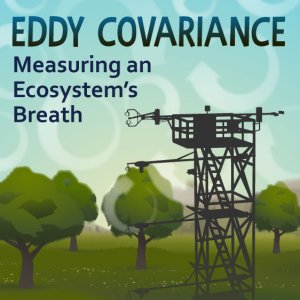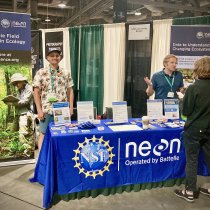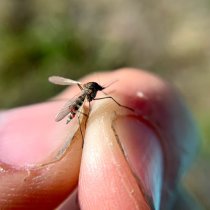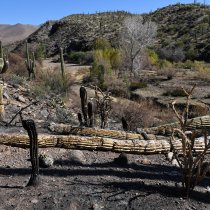Eddy Covariance Data Products Now Available on NEON Data Portal
May 21, 2018
Want to watch the planet breathe? You're in luck—a whole new set of data products that let you do just that is now available on the NEON Data Portal.
These eddy-covariance (EC) or “flux” data products give scientists a powerful new tool to monitor how energy, water, carbon dioxide and other gases move between the earth’s surface and the atmosphere.
Watching the Earth Breathe
Heat, water vapor, carbon dioxide and other gases are continually exchanged between the earth’s surface and the atmosphere. Soil, lakes and rivers, vegetation and other living things on the earth absorb energy from the sun and take in gases and water from the atmosphere, directly or through precipitation. They also radiate heat, send water back into the atmosphere through evapotranspiration, and release carbon and other gases back into the air through respiration. In a very real way, we can think of these fluxes as the planet breathing.
EC data are used to monitor this exchange at the boundary layer between living and non-living things on the earth and the atmosphere above. These EC data are collected using sensors that measure temperature, moisture and gas concentrations within the turbulent air currents that move past a flux tower. By combining these data with information about the speed and direction of the air currents themselves, we can get a picture of how energy, water and gases are flowing into and out of the atmospheric boundary layer. This video explains the process:
Looking at the net flow of energy, water and gases between the earth’s surface and the atmosphere can help us answer important ecological questions, such as the rate at which carbon is stored in the soil and the vegetation of an ecosystem. Scientists will be able to use NEON EC data to build better models for ecological forecasting or to predict how changing land use patterns could impact carbon sequestration potential, water availability and weather patterns, among other critical questions.
Turning Millions of Daily Data Points into Usable Data Products
The information collected at NEON flux towers yields 19 EC data products. Those include wind speed and direction, temperature, water vapor and carbon dioxide concentration and isotopic composition, as well as their fluxes. These data products went live on April 25 on the NEON Data Portal, where they can be downloaded in the data package "Bundled Data Products – Eddy Covariance." The Data Portal currently contains exemplary EC datasets from four NEON sites: the Bartlett Experimental Forest (BART) in New Hampshire, the LBJ National Grassland (CLBJ) in Texas, the Central Plains Experimental Range (CPER) in Colorado, and the Lajas Experimental Station (LAJA) in Puerto Rico. Data are being added from additional sites on a weekly basis.
Ultimately, the "Bundled Data Products – Eddy Covariance" will be available from all 47 flux towers located at NEON sites across the continental U.S., Hawaii and Puerto Rico. Currently, 40+ towers are fully operational, and the remaining ones are scheduled to operate by the end of the year. Once all of these sites are online, NEON will constitute the largest single-provider EC tower network in the world.
The towers collect EC data up to 40 times per second across more than 100 channels, generating millions of data points each day for each of the NEON sites. These data must be curated, processed and consolidated to generate the data products that scientists access from the NEON Data Portal. Before data products can be made available from the Data Portal, metadata such as location tagging and calibration coefficients are added to the raw data. Next, the data go through a quality control process, including basic quality checks and uncertainty analysis. Lastly, data are aggregated into the 19 discrete data products and consolidated into 1-minute and 30-minute increments. During nominal operation, anticipated availability of the final data products from the Data Portal is as early as five days after collection at the flux towers.
Putting NEON EC Data to Use for Near-Term Forecasting and Ecological Modeling
There are several other networks already collecting flux data in the U.S. and internationally, including AmeriFlux and FLUXNET, to which NEON contributes. NEON greatly expands the number of geographic areas and types of ecosystems where EC data are being collected. In addition, NEON EC data and resources offer several advances for scientists studying ecosystem fluxes:
- Near real-time data: Data from most EC networks are available months to years after collection. During nominal operation, anticipated availability of NEON EC data from the Data Portal is as early as five days after collection.
- Open source: The eddy4R-Docker software platform used by NEON is free of charge and currently being developed into open-source R-packages. This gives scientists transparency into the algorithms used to process, aggregate and consolidate the data. It will also allow scientists to do their own data manipulation to meet specific needs, for example tightening time scales further to enable minute-by-minute analysis in highly variable ecosystems.
- Broad geographic coverage: NEON's 47 flux towers provide consistent EC data on a continental scale and in all of the different types of ecosystems across North America.
- Integration with terrestrial and airborne data: EC data from the NEON flux towers are collected alongside observational and sampling data from NEON terrestrial and aquatic programs as well as remote sensing data from the NEON airborne observation platforms. This will allow scientists to investigate correlations, cause and effect across different types of data. For example, scientists can combine EC data with vegetation indices collected by remote sensing or with soil chemistry data from terrestrial sampling sites around the towers and explore their joint information content.
These attributes of NEON data and resources will help scientists build more accurate models and enable new types of analysis that have not previously been possible. The near real-time data availability will provide a better window into what happens during severe weather events such as a drought or hurricane, as well as how day-to-day weather patterns influence ecosystem fluxes. It will also be beneficial for scientists engaged in near-term forecasting: better near-term models could help with severe weather prediction and planning for land use and climate change resilience.
Scientists are already putting the available EC data to use. To date, more than 20 journal articles have been published leveraging the eddy4R-Docker software platform and NEON EC data, including a community collaboration paper examining a DevOps model for processing and analysis of EC data.
Are you using—or planning to use—NEON EC data in your research? We'd like to hear about it! Drop us a line and tell us how NEON data supports your research.



